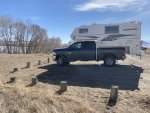mk216v
Der Chef der Fahrzeuge
Tires are the topic where I find most people think whatever they have is the "best". But many have a limited experience base of tire brands, types to even know. So most reviews are not helpful.
Key item is load capacity rating. It doesn't hurt to run a E or F rated tire. But keep in mind, you'll need to run the specified pressure to achieve the load capacity.
So far, I've appreciated the lower 50psi rating for the ~3,500lb capacity. Much easier to live with off road to on road transitions.
In my experience, this rings true for most reviews that are auto-related; most people haven't experienced enough options to be able to compare clearly. Take their mileage life with a grain of salt too; one guy gets 10k on the tires and 3 others are getting 50k. Who knows if they're all checking/adjusting tire pressures weekly or not (time consuming, yes!).
Agreed on load capacity. Again, I found it very interesting comparing 37s and 35s for my '19 F350 4x4;
These 37"/D-load are 3525lbs Max/ea at Max 50psi;
https://www.tirerack.com/tires/tire...dewall=Blackwall&partnum=725QR7GRX3&tab=Specs
These 35"/E-load are 3195lbs Max/ea at Max 65psi;
https://www.tirerack.com/tires/tire...id Red Letters&partnum=525QR7GRX3RL&tab=Specs
Most feedback here on ExPo has been get the E vs D load due to stiffer sidewalls, thus better puncture resistance offroad.
Personally I've never run 35s (E350 4x4) at anywhere near 55psi+, especially an M/T tire--just too hard, worse handling and ride comfort.
So I'm leaning towards 37s for your reason (appreciated the lower 50psi rating for the ~3,500lb capacity. Much easier to live with off road to on road transitions.).
YMMV of course.

